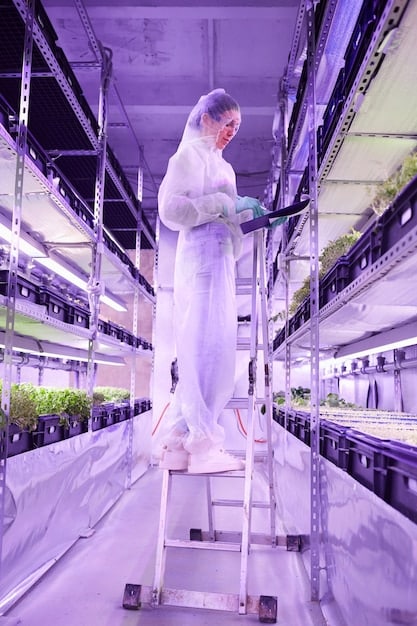Exploring the Potential of Lab-Grown Meat for US Consumers

Exploring the Potential of Lab-Grown Meat for US Consumers reveals a promising frontier in food technology, offering sustainable and ethical meat alternatives that could revolutionize the US market.
The burgeoning field of cellular agriculture is poised to transform how Americans consume meat. Exploring the Potential of Lab-Grown Meat for US Consumers involves understanding its benefits, challenges, and future implications.
The Science Behind Lab-Grown Meat
Lab-grown meat, also known as cultured meat or cultivated meat, represents a significant leap in food technology. It involves producing meat from animal cells in a laboratory setting, without the need for traditional animal agriculture. This innovative approach has the potential to address various environmental and ethical concerns associated with conventional meat production.
The Cellular Agriculture Process
The process begins with obtaining cells from livestock, such as cows, pigs, or chickens. These cells are then placed in a bioreactor, which provides a controlled environment for them to grow and multiply. Nutrients, growth factors, and other essential compounds are added to support cell proliferation and differentiation into muscle tissue.
Advantages of Cellular Agriculture
One major advantage of lab-grown meat is its potential to significantly reduce the environmental impact of meat production. Traditional livestock farming is a major contributor to greenhouse gas emissions, deforestation, and water pollution. Cellular agriculture, on the other hand, requires far less land, water, and energy, leading to a more sustainable food system.
- Reduced greenhouse gas emissions compared to traditional livestock farming.
- Minimal land and water usage, conserving natural resources.
- Elimination of animal suffering in industrial meat production.
The science behind lab-grown meat offers a compelling vision for a more sustainable and ethical approach to meat consumption, with the potential to transform the food industry in the US and beyond.

Environmental Benefits of Lab-Grown Meat
The environmental benefits of lab-grown meat are substantial and far-reaching, addressing many of the critical issues associated with traditional meat production. By shifting away from resource-intensive livestock farming, cellular agriculture offers a promising pathway towards a more sustainable and eco-friendly food system.
Reduced Greenhouse Gas Emissions
Conventional livestock farming is a major source of greenhouse gas emissions, contributing significantly to climate change. Lab-grown meat has the potential to drastically reduce these emissions by eliminating the need for large-scale animal agriculture. Studies have shown that cultured meat could reduce greenhouse gas emissions by up to 96% compared to traditional beef production.
Conservation of Land and Water Resources
Livestock farming requires vast amounts of land for grazing and growing animal feed, leading to deforestation and habitat loss. Additionally, it consumes significant quantities of water for irrigation and animal maintenance. Lab-grown meat requires significantly less land and water, conserving these precious resources and reducing environmental degradation.
- Lower greenhouse gas emissions compared to beef production
- Reduced land use, minimizing deforestation.
- Efficient water usage, conserving water resources.
By addressing these environmental concerns, lab-grown meat has the potential to transform the food industry and contribute to a more sustainable future for the US and the world.
Ethical Considerations and Animal Welfare
Ethical considerations and animal welfare are central to the debate surrounding lab-grown meat. Traditional meat production often raises concerns about animal suffering, inhumane treatment, and the overall ethics of raising animals for slaughter. Lab-grown meat offers a potential solution to these ethical dilemmas by producing meat without harming animals.
Eliminating Animal Suffering
One of the primary ethical advantages of lab-grown meat is the elimination of animal suffering. Since cultured meat is produced from cells in a laboratory, there is no need to raise, confine, or slaughter animals. This appeals to consumers who are concerned about animal welfare and seek more humane alternatives to conventional meat.
Addressing Ethical Concerns in Meat Production
Traditional meat production practices often involve intensive farming methods that can compromise animal welfare. Lab-grown meat offers a way to produce meat without these ethical trade-offs, providing consumers with a product that aligns with their values.

- No animal slaughter or inhumane treatment.
- Reduces the environmental impact of animal agriculture.
- Offers consumers an ethical meat alternative.
Lab-grown meat’s potential to alleviate ethical concerns related to animal welfare could significantly impact consumer choices and the overall trajectory of the meat industry.
Consumer Acceptance and Market Potential in the US
Consumer acceptance is a critical factor in determining the market potential of lab-grown meat in the US. While the concept has gained traction in recent years, widespread adoption depends on addressing consumer concerns, perceptions, and preferences. Understanding these dynamics is essential for the successful integration of cultured meat into the American food landscape.
Addressing Consumer Concerns
One of the main challenges is overcoming consumer skepticism and addressing concerns about the safety, taste, and nutritional value of lab-grown meat. Many consumers may be hesitant to embrace a product that is produced in a laboratory rather than through traditional farming methods. Clear and transparent communication about the production process, safety regulations, and nutritional benefits is essential to build trust and acceptance.
Taste and Texture Expectations
Another important factor is meeting consumer expectations regarding taste, texture, and overall eating experience. Lab-grown meat must closely resemble traditional meat in terms of flavor and mouthfeel to appeal to a broad audience. Ongoing research and development efforts are focused on improving the sensory attributes of cultured meat to match or exceed those of conventional products.
Market Potential
Despite these challenges, the market potential for lab-grown meat in the US is significant. As consumers become increasingly aware of the environmental and ethical implications of traditional meat production, demand for sustainable and humane alternatives is growing. Lab-grown meat offers a promising solution for meeting this demand, with the potential to capture a substantial share of the meat market in the coming years.
Regulatory Landscape and Government Oversight
The regulatory landscape and government oversight play a crucial role in shaping the future of lab-grown meat in the US. Clear and consistent regulations are essential to ensure the safety, quality, and transparency of cultured meat products. Understanding the regulatory framework is vital for both producers and consumers in this emerging industry.
FDA and USDA Regulations
In the US, the Food and Drug Administration (FDA) and the United States Department of Agriculture (USDA) are jointly responsible for regulating lab-grown meat. The FDA oversees the safety and labeling of cell-culturing processes, while the USDA regulates the production and labeling of meat products. This dual oversight aims to ensure that lab-grown meat meets the same safety standards as conventional meat.
Labeling and Transparency
Labeling requirements are a key aspect of regulatory oversight, ensuring that consumers are informed about the nature and origin of lab-grown meat products. Clear and accurate labeling can help build consumer trust and facilitate informed purchasing decisions.
- FDA and USDA jointly regulate lab-grown meat.
- Clear labeling requirements to inform consumers.
- Promoting product safety and consumer confidence.
Government oversight of lab-grown meat is continuously evolving, with ongoing discussions about the appropriate regulatory framework to govern this innovative industry. A well-defined regulatory pathway is crucial for fostering innovation, ensuring product safety, and promoting consumer acceptance.
Challenges and Opportunities in Scaling Up Production
Scaling up production is a significant challenge for the lab-grown meat industry. Transitioning from small-scale research and development to large-scale commercial production requires overcoming various technical, economic, and logistical hurdles. However, addressing these challenges also presents significant opportunities for innovation and growth.
Technological Hurdles
One of the main technological challenges is optimizing the cell-culturing process to achieve cost-effective and efficient production. This involves improving the efficiency of bioreactors, reducing the cost of growth factors, and developing scalable cell lines. Ongoing research and development efforts are focused on overcoming these technological barriers.
Cost Reduction Strategies
Reducing the cost of production is essential for making lab-grown meat competitive with conventional meat. Strategies for cost reduction include optimizing the use of resources, improving the efficiency of production processes, and exploring alternative growth media. As production volumes increase and technologies advance, the cost of lab-grown meat is expected to decrease significantly.
- Optimizing cell-culturing processes to improve production efficiency.
- Scaling up production to meet consumer demand.
- Reducing production costs to make lab-grown meat more affordable.
Overcoming these challenges and seizing the available possibilities will be vital for the widespread adoption and success of lab-grown meat in the US market.
| Key Point | Brief Description |
|---|---|
| 🌱 Sustainability | Reduces environmental impact compared to traditional meat. |
| 🐄 Ethics | Eliminates animal suffering in meat production. |
| 🔬 Technology | Involves cell-culturing in a controlled lab environment. |
| ⚖️ Regulations | Governed by FDA and USDA standards for safety and labeling. |
Frequently Asked Questions
Lab-grown meat, also known as cultured or cultivated meat, is produced by culturing animal cells in a lab, offering a sustainable alternative to traditional meat production.
Yes, lab-grown meat is designed to be as safe as traditional meat. It undergoes rigorous testing and is subject to regulatory oversight by the FDA and USDA.
It requires less land, water, and energy than traditional livestock farming, significantly reducing greenhouse gas emissions and environmental degradation.
Lab-grown meat eliminates the need for animal slaughter and reduces animal suffering, offering a more humane alternative to conventional meat production.
While lab-grown meat is available in limited quantities, widespread availability depends on scaling up production, regulatory approvals, and consumer acceptance, which is expected in the coming years.
Conclusion
Exploring the potential of lab-grown meat for US consumers reveals a transformative opportunity to revolutionize the food industry, offering sustainable, ethical, and environmentally friendly alternatives to traditional meat production. As technology advances, regulatory frameworks evolve, and consumer acceptance grows, lab-grown meat has the potential to reshape the future of food in the US and beyond.





